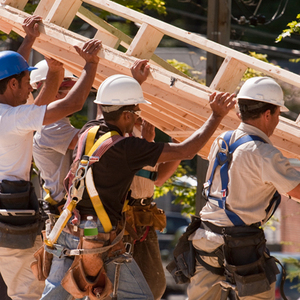The WPJ
THE WORLD PROPERTY JOURNALReal Estate Facts Not Fiction
Residential Real Estate News

New Home Starts in U.S. Down 9 Percent in February
Residential News » Denver Edition | By Michael Gerrity | March 27, 2019 8:17 AM ET
According to a new report from the U.S. Housing and Urban Development and Commerce Department, total housing starts fell 8.7 percent in February 2019 to a seasonally adjusted annual rate of 1.16 million units from an upwardly revised reading in January 2019.
The February reading of 1.16 million is the number of housing units builders would begin if they kept this pace for the next 12 months. Within this overall number, single-family starts fell 17 percent to 805,000 units following an unusually high reading of 970,000 units in January. Meanwhile, the multifamily sector, which includes apartment buildings and condos, increased 17.8 percent to 357,000.
"The overall lower starts numbers are somewhat deceiving given the revised single-family starts figure in January was at a post-recession high," said Danushka Nanayakkara-Skillington, AVP for Forecasting and Analysis at the National Association of Home Builders (NAHB). "Absent the surge last month, the drop in single-family production in February is not as huge as it appears. Still, builders continue to remain cautious due to affordability concerns, as illustrated by the flat permits data."
"The February starts figures are somewhat in line with flat builder expectations and serve as a cautionary note that affordability factors continue to affect the marketplace," said Greg Ugalde, chairman of NAHB and a home builder and developer from Torrington, Conn. "Excessive regulations, a scarcity of buildable lots, persistent labor shortages and tariffs on lumber and other key building materials are having a negative effect on housing affordability."
Regionally, combined single-family and multifamily starts in February fell 29.5 percent in the Northeast, 18.9 percent in the West and 6.8 percent in the South. Starts posted a 26.8 percent increase in the Midwest.
Overall permits, which are often a harbinger of future housing production, edged 1.6 percent lower in February to 1.30 million units. Single-family permits held steady at 821,000, while multifamily permits fell 4.2 percent to 475,000.
Looking at regional permit data, permits rose 1.5 percent in the Northeast, 4 percent in the South and 1.1 percent in the Midwest. Permits fell 15 percent in the West.
The National Association of Realtors chief economist Lawrence Yun said, "Housing starts falling in February is not what is needed to assure a sustainable housing market recovery. Home prices will rise in 2019 for sure. However, the home price increase could be too strong as homebuilders are insufficiently constructing new homes. The imbalance between demand and supply can once again lead to a case of home price appreciation outpacing income growth for the eighth straight year. That is good for homeowners accumulating wealth but not healthy for the broader market as it limits homeownership opportunity, especially among the millennials and widens intergenerational wealth inequality. More affordable homes need to be built to assure market balance and better access to homeownership."
Yun continued, "The home price deceleration as reflected in the latest Case-Shiller price index of 4.3 percent is encouraging but only when compared to what happened to January. NAR's median home price gain of only 3.6 percent in February was also welcome news. However, unless housing starts to rise consistently, home prices could soon re-accelerate upwards and lead to unaffordable housing conditions. A better scenario is more construction driving home price growth of around 3 percent, while income rushes ahead faster to about 4 percent, thereby improving housing affordability."
According to a new report from the U.S. Housing and Urban Development and Commerce Department, total housing starts fell 8.7 percent in February 2019 to a seasonally adjusted annual rate of 1.16 million units from an upwardly revised reading in January 2019.
The February reading of 1.16 million is the number of housing units builders would begin if they kept this pace for the next 12 months. Within this overall number, single-family starts fell 17 percent to 805,000 units following an unusually high reading of 970,000 units in January. Meanwhile, the multifamily sector, which includes apartment buildings and condos, increased 17.8 percent to 357,000.
"The overall lower starts numbers are somewhat deceiving given the revised single-family starts figure in January was at a post-recession high," said Danushka Nanayakkara-Skillington, AVP for Forecasting and Analysis at the National Association of Home Builders (NAHB). "Absent the surge last month, the drop in single-family production in February is not as huge as it appears. Still, builders continue to remain cautious due to affordability concerns, as illustrated by the flat permits data."
"The February starts figures are somewhat in line with flat builder expectations and serve as a cautionary note that affordability factors continue to affect the marketplace," said Greg Ugalde, chairman of NAHB and a home builder and developer from Torrington, Conn. "Excessive regulations, a scarcity of buildable lots, persistent labor shortages and tariffs on lumber and other key building materials are having a negative effect on housing affordability."
Regionally, combined single-family and multifamily starts in February fell 29.5 percent in the Northeast, 18.9 percent in the West and 6.8 percent in the South. Starts posted a 26.8 percent increase in the Midwest.
Overall permits, which are often a harbinger of future housing production, edged 1.6 percent lower in February to 1.30 million units. Single-family permits held steady at 821,000, while multifamily permits fell 4.2 percent to 475,000.
Looking at regional permit data, permits rose 1.5 percent in the Northeast, 4 percent in the South and 1.1 percent in the Midwest. Permits fell 15 percent in the West.
The February reading of 1.16 million is the number of housing units builders would begin if they kept this pace for the next 12 months. Within this overall number, single-family starts fell 17 percent to 805,000 units following an unusually high reading of 970,000 units in January. Meanwhile, the multifamily sector, which includes apartment buildings and condos, increased 17.8 percent to 357,000.
"The overall lower starts numbers are somewhat deceiving given the revised single-family starts figure in January was at a post-recession high," said Danushka Nanayakkara-Skillington, AVP for Forecasting and Analysis at the National Association of Home Builders (NAHB). "Absent the surge last month, the drop in single-family production in February is not as huge as it appears. Still, builders continue to remain cautious due to affordability concerns, as illustrated by the flat permits data."
"The February starts figures are somewhat in line with flat builder expectations and serve as a cautionary note that affordability factors continue to affect the marketplace," said Greg Ugalde, chairman of NAHB and a home builder and developer from Torrington, Conn. "Excessive regulations, a scarcity of buildable lots, persistent labor shortages and tariffs on lumber and other key building materials are having a negative effect on housing affordability."
Regionally, combined single-family and multifamily starts in February fell 29.5 percent in the Northeast, 18.9 percent in the West and 6.8 percent in the South. Starts posted a 26.8 percent increase in the Midwest.
Overall permits, which are often a harbinger of future housing production, edged 1.6 percent lower in February to 1.30 million units. Single-family permits held steady at 821,000, while multifamily permits fell 4.2 percent to 475,000.
Looking at regional permit data, permits rose 1.5 percent in the Northeast, 4 percent in the South and 1.1 percent in the Midwest. Permits fell 15 percent in the West.
Sign Up Free | The WPJ Weekly Newsletter
Relevant real estate news.
Actionable market intelligence.
Right to your inbox every week.
Real Estate Listings Showcase
Related News Stories
Residential Real Estate Headlines
- U.S. Home Sales Continue Slump in April Despite Growing Inventory
- Opportunity Zone Home Prices Surpass National Growth in Half of U.S. Markets
- Spring Home Sales Sputter in U.S. as High Costs Weigh on Buyers
- Ireland's Residential Rents Surge in Early 2025, Fastest Rise in Two Decades
- U.S. Homebuilder Confidence Drops Sharply in May, Hits 3 Year Low
- U.S. Cities Where Renters Need $100K Salary to Live Doubles Since 2020
- Tuscany's Property Boom Driven by Wealthy Foreign Buyers
- Home Price Appreciation Continues to Slow in U.S.
- California Home Sales Dip in March Amid Rising Economic Concerns
- U.S. Mortgage Rates Continue Downward Trend
- Pending Home Sales in U.S. Increase in March
- U.S. Home Values Flatline in March as Sellers Outnumber Buyers
- Greater Miami Area Residential Sales Cool in March
- NAR Reports Existing Home Sales Tumble in March, Hit 16-Year Low
- U.S. New Home Sales Uptick in March
- Florida's California Moment: Skyrocketing Housing, HOA and Insurance Costs Take Center Stage in 2025
- Home Seller Concessions Climbing as Market Conditions Shift in U.S.
- SENTIENT MORTGAGE Consumer-to-Lender AI Matching Engine Commences Development
- U.S. Homes Sold at Slowest Pace in 6 Years in March, Demand Sluggish
- Trump Tariffs Test U.S. Housing Markets Reliance on International Trade
- India Home Prices Nationwide Climbed 9 Percent Annually in 2024
- U.S. Home Remodeling Industry Sentiment Declines in Early 2025
- Canadian Home Sales Slide in February Amid U.S. Trade Tensions
- Americans Spent $603 Billion on Home Remodeling Projects in 2024
- U.S. Mortgage Demand Spikes 20 Percent in Early April as Rates Drop
- Las Vegas Area Home Prices Uptick 4.3 Percent Annually in March
- Single-Family Rent Growth in U.S. Trends Upward in 2025
- U.S. Mortgage Rates Tick Down Post Trump Tariffs Commencement
- President Trump's 'Liberation Day' Tariffs Potential Impact on the U.S. Housing and Mortgage Markets
- Baby Boomers Biggest Cohort of U.S. Home Buyers in 2025 as Millennials Decline
- U.S. Monthly Housing Payments Hit Record High in 2025
- U.S. Pending Home Sales Uptick in February
- Global Prime Residential Rent Slowdown Continued in Late 2024
- Ireland Home Price Inflation Hits 8 Year High in Early 2025
- Existing Home Sales in America Uptick in February
- Great Miami Area Residential Sales Decline 15 Percent Annually in February
- Mortgage Rates Uptick in Mid-March, Ending 9-Week Decline in U.S.
- World Property Ventures Builds the Future of Real Estate with New Funding Round
- U.S. Builder Sentiment Declines Amid Economic Uncertainty and Rising Costs
- Black Homeownership Rates in U.S. Enjoy Largest Annual Increase of All Racial Groups
Reader Poll
Marketplace Links
This website uses cookies to improve user experience. By using our website you consent in accordance with our Cookie Policy. Read More





